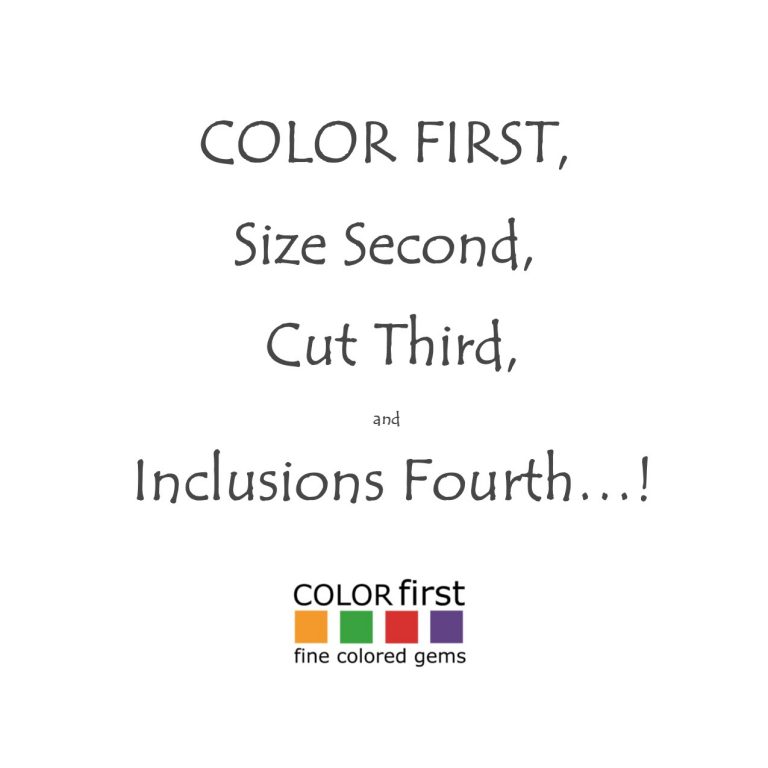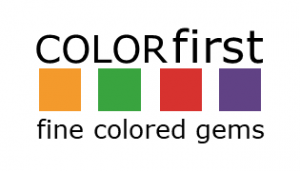COLOR First, Size Second, Cut Third and Inclusions Fourth…!

Most of us have heard about the 4 C’s of Diamond Quality, developed by the GIA: Color, Clarity, Cut and Carat Weight. https://4cs.gia.edu/EN-US/the-diamond-4-cs.htm
When it comes to Colored Gemstones, the same factors are important but not necessarily in the same order. We have to keep in mind how rare most Colored Gemstones are, in relation to Diamonds.
According to statistics produced by the Kimberly Process, over 127 million carats of rough Diamonds were produced in 2015. In comparison, total production for a Colored Gemstone like Tsavorite Garnet may be in the region of 100,000 carats of rough per year, a tiny fraction of Diamond production!
So that leads us to the question: What is Truly Rare?
Going by production volumes alone, the majority of Colored Gemstones are far, far rarer than Diamonds! Yet the power of marketing has led to dramatically increased values for Diamonds over the past 6 decades, relative to all other Gemstones.
The reality of rarity changes the factors which should be considered when assessing a Colored Gemstone. In order of importance:
COLOR
Clearly the aspect which catches our attention first. Hence our name COLOR First! In general, purer hues are more valuable. However, ultimately it is the color that speaks to you personally that is most important.
CARAT WEIGHT or SIZE
Considering how few Colored Gemstones are produced relative to Diamonds, it is remarkable to find a large Gemstone in almost any type of material. In general, the bigger the better, although in some cases values per carat don’t increase exponentially with size. That means some large Gemstones are still bargains!
CUT
This can transform an unremarkable piece of the earth into a true gem. All you have to do to appreciate cutting is look at some of the pieces that win AGTA’s Spectrum Awards each year: https://agta.org/spectrum/. It is amazing to see what the correct cutting angles and proportions can do to highlight the beauty inherent within a gemstone.
CLARITY or INCLUSIONS
It is perfectly acceptable for a Colored Gemstone to have small inclusions. In general, the less the better, and ideally they shouldn’t detract from the overall beauty of the Gemstone, face-up. In fact, clean Colored Gemstones are simply described as eye-clean, and not loupe-clean as with Diamonds. Some Gemstones actually need inclusions in order to be valuable, e.g. Cats-eye stones, Moonstones, Demantoid Garnets with horsetails, or even the silk that gives the velvety look of a fine Kashmir Sapphire. From an artistic perspective, photomicrographs of some inclusions in gemstones look like abstract art – it is another world inside these beautiful gemstones! Looking out at the future, as synthetics get better and better, one of the only way labs will be able to distinguish between natural and synthetics will be using the inclusions present within Gemstones. In addition to this, gemstones with inclusions usually sell at a discount based on the extent of the inclusions, making them a little friendlier on the pocket. So it’s almost a bonus to have a small inclusion in a Gemstone. They’re not imperfections – consider them Fingerprints of Nature.
When buying a gem, the stone should always speak to you. Okay…we don’t mean that literally…!! It should express the qualities that matter to you most – the color, the size, the sparkle (a function of the stones physical properties as well as the cutting quality), the shape, and finally the clarity.
